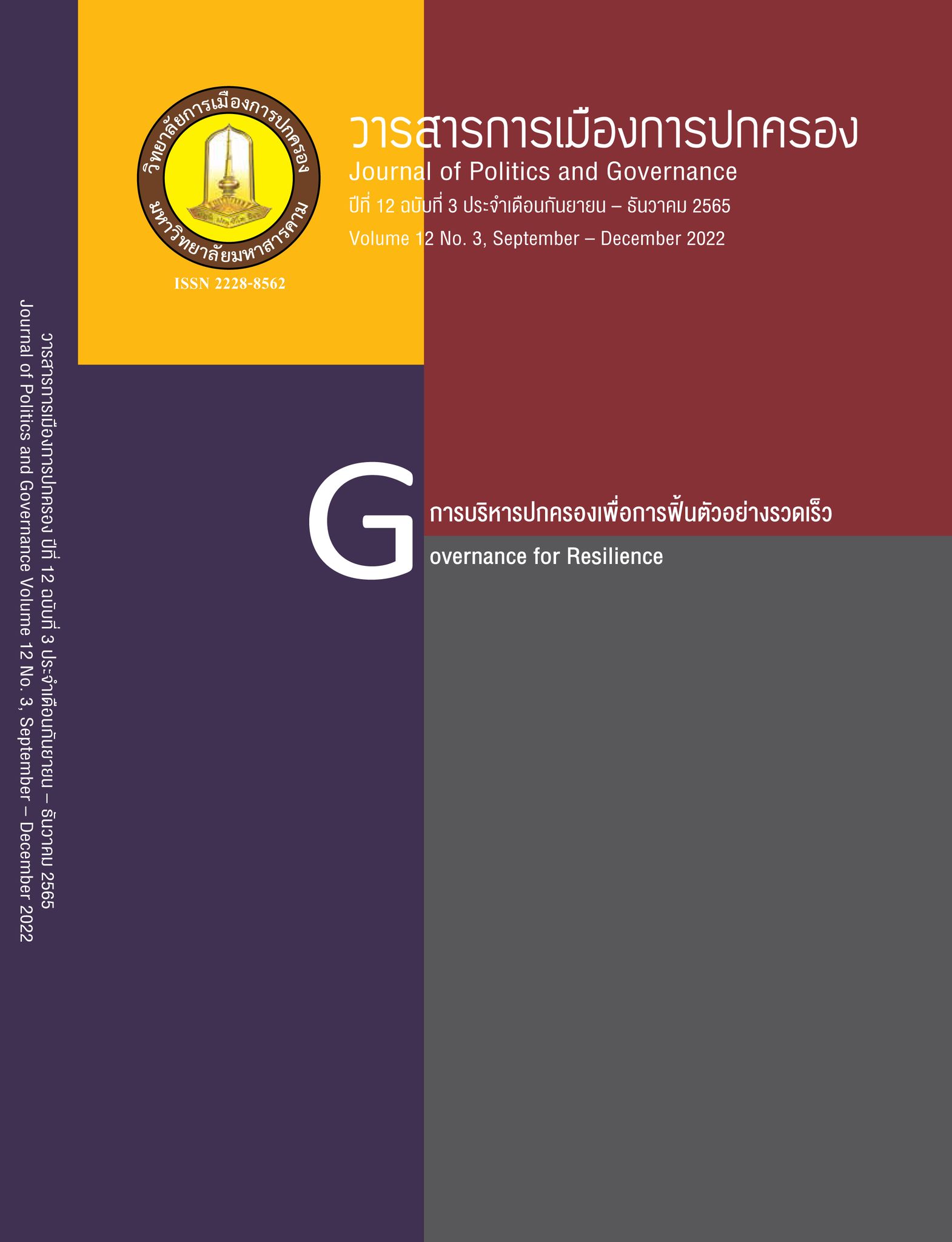The Development of Government Agency Preparedness Potential: A case study of Coronavirus 2019 (COVID-19) Pandemic in Mueang District, Nakhon Ratchasima Province
Main Article Content
Abstract
The purposes of this research were to 1) study about the government agency preparation in a case study of Coronavirus 2019 (COVID-19) pandemic and 2) suggest guidelines for development of government agency preparedness potential in a case study of Coronavirus 2019 (COVID-19) pandemic in Muang District, Nakhon Ratchasima Province. This research used qualitative research and data were collected from groups of key informants which were within 8 administrative organizations as follows 1) personnel of local administrative organizations consisting of the chief administrator of the Local Government Organization, Permanent Secretary of Local Administrative Organization, Operational Disaster Prevention and Mitigation Officer, and Health and Environment staffs, 2) personnel within 8 health organizations in Health Promoting Hospital consisting of: Director of Health Promoting Hospital, professional nurses and health workers and 3) community representatives including community leaders, village health volunteers, and civil defense volunteers within 8 communities. Data were analyzed by content analysis. The findings indicated that 1. the preparation of government agencies in a case study of Coronavirus 2019 (COVID-19) pandemic consisted of 1) policies and action plans in collaboration with relevant agencies, 2) alerting news and setting surveillance measures before the outbreak, 3) communication by using personal media and online communication, 4) database preparation system and utilization of information, and 5) crisis management by creating operational plans, coordinating and preparing equipment. 2. the development of government agency preparedness potential in a case study of Coronavirus 2019 (COVID-19) pandemic consisted of strict policy management, planning development for efficiency management evaluation, development of surveillance, notification system, development of communication system, database system development, education promotion, and promotion of the establishment of local coordination centers.
Article Details
References
กระทรวงสาธารณสุข . (2563). แนวทางปฏิบัติด้านสาธารณสุข เพื่อการจัดการภาวะระบาดของโรคโควิด-19 ในข้อกำหนดออกตามความในมาตรา 9 แห่งพระราชกำหนดการบริหารราชการในสถานการณ์ฉุกเฉิน พ.ศ. 2548 (ฉบับที่ 1). กรุงเทพฯ: บริษัท ทีเอส อินเตอร์พริ้นท์ จำกัด
กรมป้องกันและบรรเทาสาธารณภัย. (2557). หนังสือคำศัพท์ด้านการบริหารจัดการความเสี่ยงจากภัยพิบัติ. กรุงเทพฯ: กรมป้องกันและบรรเทาสาธารณภัย กระทรวงมหาดไทย. สืบค้นจาก https://www.disaster.go.th
พิมณทิพา มาลาหอม, พนมวรรณ์ สว่างแก้ว, และวิชิต พุ่มจันทร์ (2564). พลังชุมชนกับการเฝ้าระวังควบคุม และป้องกันการระบาดของโควิด–19 ในชุมชนชายแดนไทย – ลาว. Covid-19 โรคเปลี่ยนคนคนเปลี่ยนโลก’63 Series. ศูนย์มานุษยวิทยาสิรินธร. สืบค้นจาก https://www.sac.or.th/main/th/article/detail/186
ราชกิจจานุเบกษา. (2550). พระราชบัญญัติป้องกันและบรรเทาสาธารณภัย พ.ศ. 2550. ประกาศ ณ วันที่ 7 กันยายน พ.ศ. 2550 (ราชกิจจานุเบกษา, 2550 เล่ม 124 ตอนที่ 52 ก หน้า 2). สืบค้นจาก http://www.ratchakitcha.soc.go.th/DATA/PDF/2563/E/098/T_0040.PDF
ศิรศักย เทพจิต. (2563). COVID-19 Pandemic: การตอบสนองเชิงนโยบายสาธารณะในการรับมือกับปัญหาพยศ. เศรษฐสาร. สืบค้นจาก http://www.setthasarn.econ.tu.ac.th/blog/detail/59/
สุทัศน์ โชตนะพันธ์. (2559). การป้องกันภาวะวิกฤติโรคระบาด. วารสารบำราศนราดูร, 10(3), 143-156. สืบค้นจาก http://bamras.ddc.moph.go.th/userfiles/icn.pdf
สุภาวดี พรหมบุตร, สินธุ์ สโรบล, บงกชมาศ เอกเอี่ยม, และปรารถนา ยศสุข. (2554). การกำหนดนโยบายสาธารณะด้านสุขภาพ ในเขตเทศบาลเมืองแม่โจ้ อําเภอสันทราย จังหวัดเชียงใหม่เอกสารการประชุมวิชาการงานวิจัยระดับบัณฑฺิตศึกษา ครั้งที่ 12 จัดโดยบัณฑฺิตวิทยาลัย มหาวิทยาลัยขอนแก่น, 1397- 1403. สืบค้นจาก https://gsbooks.gs.kku.ac.th/54/grc12/files/hmp10.pdf
สำนักงานสภาความมั่นคงแห่งชาติ สำนักนายกรัฐมนตรี. (2560). แผนเตรียมพร้อมแห่งชาติ (พ.ศ. 2560 – 2564). สืบค้นจาก http://www.nsc.go.th/?page_id=543
Baas, S., Ramasamy, S., Pryck, J. D., & Battista, F. (2008). Disaster risk management systems analysis. Rome: Food and Agriculture Organization of the United Nations. Retrieved from http://www.fao.org/3/i0304e/i0304e.pdf
Bhagavathula, S. A., Aldhaleei, A. W., Rahmani, J., Mahabadi, A. M., & Bandar, K. D.(2020). Knowledge and Perceptions of COVID-19 Among Health Care Workers: Cross-Sectional Study. JMIR Public Health Surveill, 6(2), e19160. Retrieved from https://publichealth.jmir.org
Cheng. H., & HUANG. A. S. (2021). Proactive and blended approach for COVID-19 control in Taiwan. Biochemical and Biophysical Research Communications, 538, 238-243. Retrieved from https://www.sciencedirect.com/science/article/pii/S0006291X20320295
Coccolini, F., Perrone, G., Chiarugi, M. et al. (2020). Surgery in COVID-19 patients: operational directives. World Journal of Emergency Surgery, 15, 25(2020). Retrieved from https://doi.org/10.1186/s13017-020-00307-2
Dutta. A., & Fischer. H. W. (2021). The local governance of COVID-19: Disease preventionand social security in rural India. World Development, 138(105234). Retrieved from https://www.sciencedirect.com/science/ article/pii/S0305750X20303612
Mackworth -Young, Rudo Chingono, Constancia Mavodza, Grace McHugh, Mandikudza Tembo, Chido Dziva Chikwari, Helen A Weiss, Simbarashe Rusakaniko, Sithembile Ruzario, Sarah Bernaysh & Rashida A Ferrand. (2021). Community perspectives on the COVID-19 response, Zimbabwe. Bull World Health Organ, 99, 85–91. Retrieved from Community perspectives on the COVID-19 response, Zimbabwe http://dx.doi.org/ 10.2471/BLT.20.260224
Mei, C. (2020). Policy style, consistency and the effectiveness of the policy mix in China’s fight against COVID-19. Policy and Society, 39(3), 309-325. Retrieved from https://www.tandfonline.com/doi/full/ 10.1080/14494035.2020.1787627
Reddy. B.V., & Gupta. A (2020). Importance of effective communication during COVID-19 infodemic. J Family Med Prim Care. 9(8), 3793–3796. Retrieved from https://www.ncbi.nlm.nih.gov/pmc/articles/PMC7586512/


